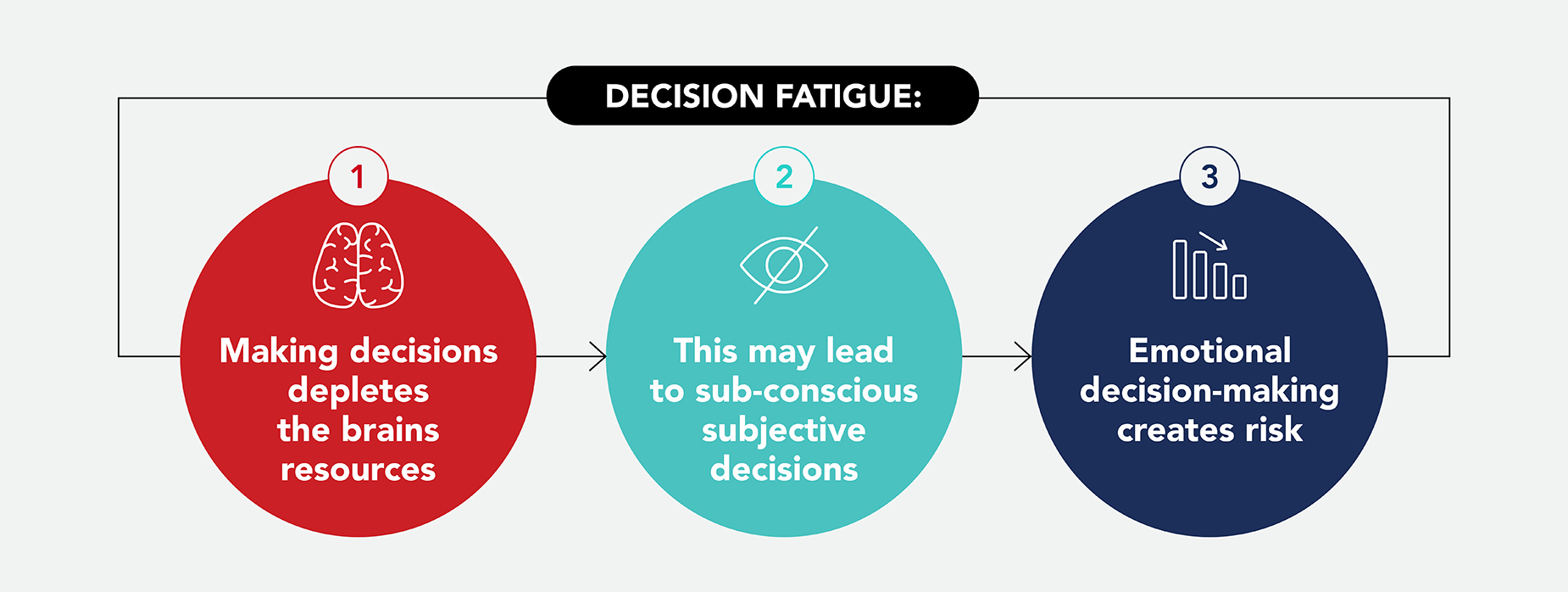Leadership has always been about the ability to make decisive decisions – especially during times of crisis. To quote the late management consultant Peter Drucker: “Wherever you see a successful business, someone once made a courageous decision.” But in the era of COVID-19, never before have we seen so many business leaders making seemingly “life or death” decisions impacting their people, their customers, and the future of their company.
Over the past couple of months, leaders have been asked to have a never-ending capacity to make tough decisions. But if we look at neuroscience, we know that’s not possible. Basic decision-making includes complex, personal, and emotionally led human processes. This creates a risk of “decision fatigue.”

If you are a leader, there are three things you can do to make better decisions now, and as you begin to rethink the future of work and what it means for your organization as you move from recovery to growth:
1. KEEP DECISION FATIGUE OUT OF VIRTUAL MEETINGS
An empirical study demonstrated that judges made more favorable parole decisions first thing in the morning and following breaks vs. before a break or at the end of the day.1 This is because making decisions depletes the brain’s precious resources. Our decisions are significantly affected by extraneous variables such as time of day, mental capacity, and the number of breaks, and they are not purely based on logic, data, facts, and rationale. When the brain’s resources are depleted, it defaults to sub-conscious, subjective decisions based on emotions that may put your business at risk.
To ensure the most effective decisions are made in a virtual setting:
- Protect time and space in schedules for important decision-making – and make that space as human as possible. Enable online meeting tools, switch the camera on, set ground rules for being just as candid and frank as you would be in face-to-face settings, and allow time for small talk.
- Be conscious that emotions are likely to be high during times of stress, and remain focused on the data that informs the decision. Appoint a member of the group with a strength in this area to steward the group with facts.
- Use anonymized polling online to share honest, individual viewpoints and avoid “groupthink,” where the desire for harmony overrides sharing true opinions.
2. BEWARE OF NATURAL BIAS
While our brains are powerful, they are subject to limitations, which means we often and subconsciously shortcut information to quickly make decisions. For example: seeking information that confirms what we want to hear; depending too heavily on an initial piece of information offered, even if un-related; or placing greater value on information that comes to your mind quickly.
To overcome such biases in decision-making:
- Increase self-awareness of the types of biases we and others may be subjected to and watch out for them.
- Insist and interrogate the data – and assess this data logically during decision-making.
- Seek input from a diverse group of people for an increased variety of perspectives, greater insights, and increased creativity in idea generation.
3. RELY ON “HEAD, HEART AND GUTS” WHEN IT COMES TO TALENT
Securing your talent – your most important asset – is one of, if not the most competitive and costly activities an organization needs to do well to be successful. When faced with uncertainty, crises and economic downturns, leaders also face the most difficult decisions regarding talent – balancing what’s best for the business and its people in the short vs. long term.
To help make the best decisions about your talent base:
- Calculate the real cost of replacement for recruitment, onboarding, and performance to inform logical decision-making with data from the start.
- Balance logical reasoning with ethical reasoning – set criteria against your organization’s values, making sure to take the human impact into account.
- Decisions about your talent are likely to be the toughest, so approach these decisions with rigor and then stand by them.
When choices mean consequences with both business and human impact, understanding how the human brain craves logic (yet defers to subjective, emotional biases) is key.
1 Danziger, Shai, Jonathan Levav, and Liora Avnaim-Pesso. “Extraneous Factors in Judicial Decisions,” 2011